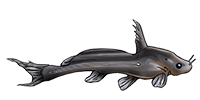https://doi.org/10.1111/1365-2435.13301
Abstract
1.Herbivorous ectothermic vertebrates are more diverse and abundant at lower latitudes. While thermal constraints may drive this pattern, its underlying cause remains unclear. We hypothesized that this constraint stems from an inability to meet the elevated phosphorus demands of bony vertebrates feeding on P‐poor plant material at cooler temperatures because low gross growth efficiency at warmer temperatures facilitates higher P ingestion rates. We predicted that dietary carbon:phosphorus (C:P) should exceed the threshold elemental ratio between carbon and P‐limited growth (TERC:P) for herbivores feeding at cooler temperatures, thereby limiting the range of herbivorous ectothermic vertebrates facing P‐limited growth.
2.We tested this hypothesis using the Andean suckermouth catfishes and . Astroblepus are invertivores that inhabit relatively cool, high‐elevation, streams while Chaetostoma are grazers that inhabit relatively warm, low‐elevation streams. We calculated TERC:P for each genus across its elevational range and compared these values to measured values of food quality over an elevational gradient in the Andes. We also broadly summarized measurements of TERC:P across diverse groups of fishes.
3.Supporting our hypothesis, we found that dietary C:P was predicted to exceed the TERC:P for the grazer Chaetostoma near the highest elevation where this genus has been recorded. Conversely, the TERC:P for the invertivore Astroblepus was consistently higher than that of Chaetostoma and thus its dietary C:P never approached the TERC:P. We found that, among all fishes, omnivores had higher average TERC:P than invertivores, and TERC:P did not vary with temperature.
4.Our results suggest that, at least for Andean suckermouth catfishes, cool temperatures constrain herbivory at higher elevations. Increased gross growth efficiency at cooler temperatures evidently restricts the ability of P‐limited consumers to meet P demand. However, our survey of fish TERC:P estimates suggests that some fishes are able to circumvent this constraint through behavioral and life history adaptations that reduce P demand or increase P use efficiency.
5.The physiological tradeoffs underlying these functional shifts reveal that geographic dietary patterns can be predicted by stoichiometric theory, but variation in food quality and consumer traits that reduce P demand and/or increase P efficiency can create exceptions to these patterns.






